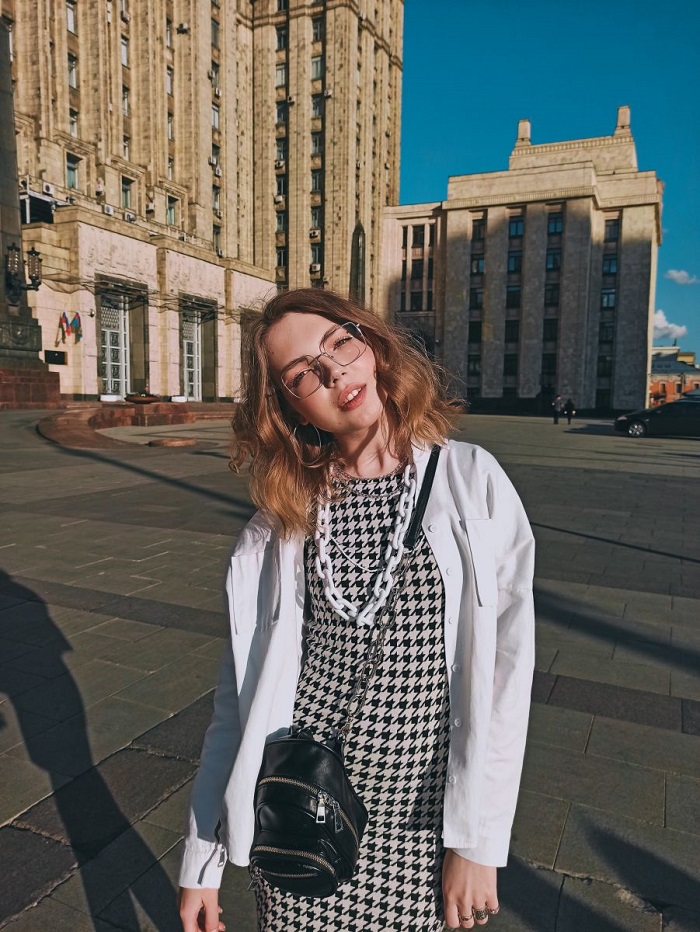RUDN University art student will talk about deconstructivism in fashion at the forum “Science of the Future — Science of the Young”
“If in the 90s the Mugler fashion house presented images of hypertrophied femininity, and Chanel demonstrated timeless tweed classics, then Margiela created dresses from plastic bags, sleeveless jackets from broken dishes, vests from scraps of newspapers and playing cards. Innovation is obvious!” says Elizaveta Krivonosova.
If you are not familiar with the term “deconstructivism” and do not understand how it applies to fashion, then above you have just seen an example of contrasting fashion before and after being influenced by deconstructivism.
Why can we talk about fashion in the context of science today?
The history of fashion and costume is a huge layer of culture that can tell about society no less than folklore or, for example, paintings. Clothing is not only pragmatism and aesthetics, it is a real cultural code. Therefore, the study of this area can enrich our knowledge about man.
Your research topic is “Deconstruction and Innovative Modeling Principles in Experimental Fashion”. What is this and what does Jacques Derrida’s theory of deconstruction have to do with it?
I study experimental fashion design and the possibilities of interpreting its methodology through the lens of Derrida’s theory of deconstruction. In simple terms, deconstruction is the destruction of worldview paradigms and the criticism of language as a tool of knowledge. The topic may seem ambiguous due to the disciplinary gap. Nevertheless, it is promising for the development of fashion theory and the development of a unified system for studying the latest fashion practices, the source of which is in the work of deconstructivist designers. Experimental fashion is something that in the conventional sense is not fashion, it is a game with tradition, its negation.
I explored the early collections of fashion designer Martin Margiela. Their visual component is based on the principle of inversion, it broadcasts ideas in line with postmodern thought. Why did I consider the work of this particular author? Margiela’s work is an absolutization, even, in a sense, a radicalization of the principles of deconstructivism in fashion. His works were the most indicative for the defense of the theses. The triumph of anti-fashion is what manifests the creativity of the Belgian designer, who denies not only the traditional aesthetics of the costume, but also the dogma of the entire fashion industry.
Why did you choose this topic and how does deconstructivism differ from other fashion trends?
I like postmodern philosophy, in particular the critique of language. I also like interdisciplinary research, in which different fields of knowledge are combined. Thus, the fashion theorist Allison Gill proposed the idea of the possibility of interpreting fashionable deconstructivism through the concept of Derrida. Having delved into the topic, I decided to try to conduct an independent analysis.
The cardinal difference between deconstructivism and other schools is that deconstructivism is not a fashionable trend. It is rather about anti-fashion — the opposition to the usual standards and canons within the sphere.
What fashion stereotypes does deconstructivism destroy? Do you follow this style of dress?
Deconstructivism abandons standards, blurring the boundaries between men’s and women’s clothes. It levels the images of the “ideal” body, its proportions, forming ideas about a new free physicality. Deconstructivism goes against the trends in fashion, it rethinks the usual clothes attributes and methods of working with products. Moreover, Margiela also denies the rules of the industry: his shows are not a traditional social event, but a real performance.
For me, deconstructivism is rather an ideal object. Although in our time we are all apologists for deconstructivism to one degree or another, sometimes without noticing it: torn jeans, sizeless sweaters and unisex are deconstructivist items.
Why did you decide to participate in the forum?
The application was sent on the advice of Yulia Kirsanova, a lecturer at the Department of Theory and History of Culture. I am very grateful to her for this! A sense of responsibility has overcome self-doubt, which, I confess, I am very happy about.
As far as I know, more than 3,400 works were sent to the competition. All studies were scientifically reviewed and evaluated by an independent jury. According to the results of the check, the top 10% of the rating reached the final for oral presentation of the work at the forum in Novosibirsk.
I have to admit, I don’t have any scientific publications or experience of participating in conferences and competitions yet. This is due to my indecision and perfectionism. Now I’m trying to catch up. I recently submitted an article to the competition that analyzes the work of Japanese fashion designer Rei Kawakubo. I am glad that the forum unexpectedly became the beginning of this path. I am moving the other way: from a multipage personal research to articles.
It was unexpected to be on the list of finalists, which is why the degree of positive emotions is even higher! The forum is coming soon, so I’m really working hard to get ready!
Sergey Ivanov, a scholar from St. Petersburg, has been named the first winner of RUDN University’s International Prize for Scientific Achievements in Mathematics, worth 5 million rubles.
Products derived from microalgae represent a cutting-edge development in the field of bioeconomy. The potential of this biological resource was discussed at the international research seminar “Foundations for a Green Sustainable Energy”, part of the BRICS Network University’s thematic group on “Energy”. The event was organized by the Institute of Ecology at RUDN University.
Ambassadors of Russian education and science met at a conference in RUDN University to discuss how they can increase the visibility of Russian universities and research organizations in the world, and attract more international students in Russia.

